Are you ready to discover untapped potential and seize hidden opportunities in the market? Today, finding a gap in the market can be the key to finding new ideas and building a successful business. It’s about identifying unmet needs, addressing pain points, and offering unique solutions that set you apart from the competition.
This comprehensive resource will dive deep into the strategies and techniques that will help you identify and exploit hidden opportunities in your industry. If you find the gap in an established market, you are one-half of your long-lasting business success. This is a critical success factor in the business world. Get ready to unleash your entrepreneurial spirit and achieve remarkable success.
Understanding Market Gaps and Their Importance
Market gaps are the niche markets lacking products, services, or solutions that adequately address the specific target audience’s needs. This untapped market allows entrepreneurs and businesses to fill the gap and satisfy customers’ unmet needs. Understanding gaps is crucial because it will enable you to differentiate yourself from competitors and create unique value propositions.
Related: The Difference Between Your Value Proposition and Positioning Statement
What is a Gap in the Market?
A market gap or an opportunity is an unmet consumer need, demand, or unsolved problem within a specific market segment. It represents a space in the market where existing products or services fall short of fulfilling these needs or where no such offerings exist. The gap in the market is an area where you can dominate. But, you must ensure the market is large enough to sustain growth.
For example, the rise of online collaboration platforms indicates a gap in the market. As more businesses move their operations online, there’s an increasing demand for tools to facilitate effective remote collaboration.
The Importance of Identifying the Gap in the Market
Identifying market gaps allows you to find a unique niche market where you can compete effectively and enjoy high-profit margins. By filling a market gap, companies can differentiate themselves from competitors, add customer value, and create a strong brand identity.
Related: How to Beat Competition in Business? 13 Steps to Beat Your Competition
Moreover, understanding the gap in the market can lead to innovation and growth. It encourages businesses to think creatively and develop inventive solutions to meet consumer needs.
So, you will need to prepare yourself to be able to see something for your entrepreneurial career. Something that you can provide on the market. Something that no one else has provided until now. It doesn’t matter if it is a product or service, your total offer, or an extraordinary customer experience. You will need to differ from other players in the market.
Related: 10 Reasons Being An Entrepreneur Is Better Than Employment
There are also disruptive products as a result of disruptive innovation. Here is an excellent video in less than 2 minutes explaining Clay Christensen’s theory of disruptive innovation.
What Create Market Gaps?
Various entities and factors can create gaps inside a specific market. Here are some of them that you will need to check and monitor if you want to find something suitable for you:
- Technological innovations and scientific discoveries. Technological innovations often create new markets but also some gaps inside existing ones. For example, the invention of smartphones created a gap for mobile applications. Companies like Uber and Airbnb exploited this gap by offering previously unavailable services through smartphones. On the other side, scientific discoveries can lead to the creation of entirely new industries. For example, biotechnology discoveries have led to genetically modified food’s development, creating a totally new market.
- Legislation. Local, state, or federal legislation can also create gaps inside existing markets. New laws or regulations can generate demand for products or services that help individuals or businesses comply with these laws. For example, data privacy laws have created a gap for companies offering data compliance solutions. To stay well-informed about changes in pending legislation, you can sign up for updates from reputable trade organizations. These organizations track pending legislation, ensuring you are always in the loop and updated with the latest things that will be active tomorrow.
- Change in consumer behavior. Changes in consumer behavior can lead to gaps in an existing market. For example, the increasing awareness and concern about environmental sustainability have led to a growing demand for eco-friendly products and services.
- Economic changes. Economic changes, such as recessions or periods of economic growth, can also create specific market gaps. For example, the financial crisis of 2008 led to a surge in demand for affordable, budget-friendly goods and services.
- Geographic and demographic changes. Changes in population demographics or geographic distribution also create gaps. For example, an aging population may create a demand for products and services tailored toward older people.
- Cultural shifts. Changes in cultural norms and values can also bring gaps inside some markets. For example, the increasing acceptance and legalization of cannabis in many parts of the world have led to a booming cannabis industry.
Steps to Identify a Gap in the Market
1. Start With a Comprehensive Market Research
Market research is a critical component of identifying the gap in the market.
You must find and analyze data about the target market, industry trends, consumer preferences, and competitor offerings. This involves gathering, analyzing, and interpreting information about a market, including its customers, competitors, and trends.
Market research can help you understand what products or services customers currently use, their level of satisfaction with current offerings, and what they feel is missing.
One practical approach to identifying a market gap is to analyze competitor weaknesses and customer pain points. You can identify areas where they fail to meet customer needs. Also, you can look for common complaints or negative customer feedback, indicating potential market gaps.
Customer surveys and interviews can provide valuable insights into their pain points and unmet needs. By listening to your potential customers and understanding their challenges, you can identify business opportunities to create innovative solutions that address those pain points.
When I explain how you can validate your ideas, I show how to use Amazon to find negative reviews and problems that some specific product doesn’t solve for customers. You can also use TrustPilot or Yelp to conduct a similar analysis:
- Start by analyzing customer reviews of products or services similar to what you offer or plan to offer. When you find something, look for negative reviews to find common complaints or suggestions. These could indicate a gap in the market that your business could fill. For example, if customers consistently complain about poor customer service, there may be a gap for you to excel in the customer service area.
- Keep an eye on your competitors’ reviews. If customers are unhappy with certain aspects of their product or service, this could present an opportunity for your business to step in and fill that gap.
- Look for trends in the reviews. Are customers asking for a feature that doesn’t currently exist? Is there a common problem that no one has solved yet? These trends can help you spot a potential gap in the market.
- Collect these data and then conduct qualitative business research to analyze the data, find the trends, and make appropriate data-based decisions.
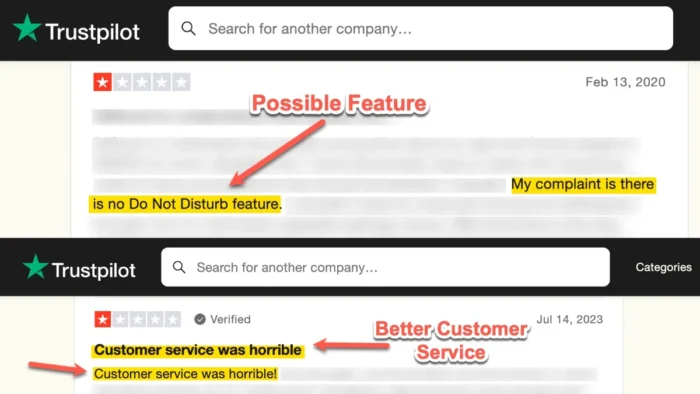
2. Conduct Competitive Research
Competitive research involves identifying your main competitors and analyzing their products, sales, and marketing strategies. By understanding what your competitors are doing, you can identify market gaps they have overlooked.
Here’s an example of how you can use competitive research to identify a market gap:
- First, identify who your competitors are. These could be businesses that offer similar products or services, operate in the same industry, or target the same customer base. Include direct competitors (those who provide the same products or services) and indirect competitors (those who offer different products or services but target the same customers).
- Collect data on your competitors’ products, services, prices, marketing strategies, customer reviews, etc. You can do this through online research, customer surveys, industry reports, and more. Take a closer look at their existing product, features, price rates, and customer satisfaction level. Analyze this data to understand what your competitors are doing well and where they fall short.
- Finally, evaluate your findings to identify a potential gap in the market. These could be unmet customer needs, underserved segments, opportunities for innovation, etc. Make a table similar to the image below and record all the data you find to analyze your competitors.
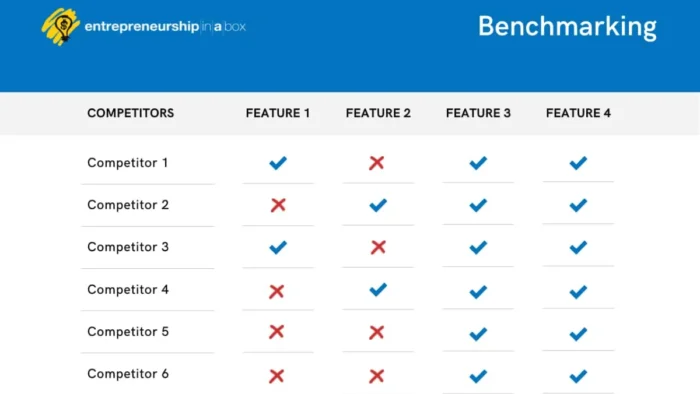
3. Conduct SWOT Analysis
The SWOT analysis can also help you identify gaps in the market. By understanding your company’s strengths and weaknesses and the opportunities and threats in the market, you can uncover areas where your competitors are not performing well, customer needs are unmet, or problems are unsolved.
Your strengths are based on your competence, knowledge, skills, and experience. It is something you like to do, and when you are doing it, the outputs are unique compared to others. Prepare yourself to take the following steps:
- Create a list of your most significant strengths.
- Describe all the strengths you have listed in the previous step.
- List the things you can do depending on those strengths.
- Relate your strengths and the things you can do with possible problems. Problems that you can solve for other people.
In such a way, you will know what you can do with your most significant strengths.
Then you can repeat the same process for weaknesses, opportunities, and threats.
Let’s consider an example from the retail industry, specifically a SWOT analysis for your boutique clothing store:
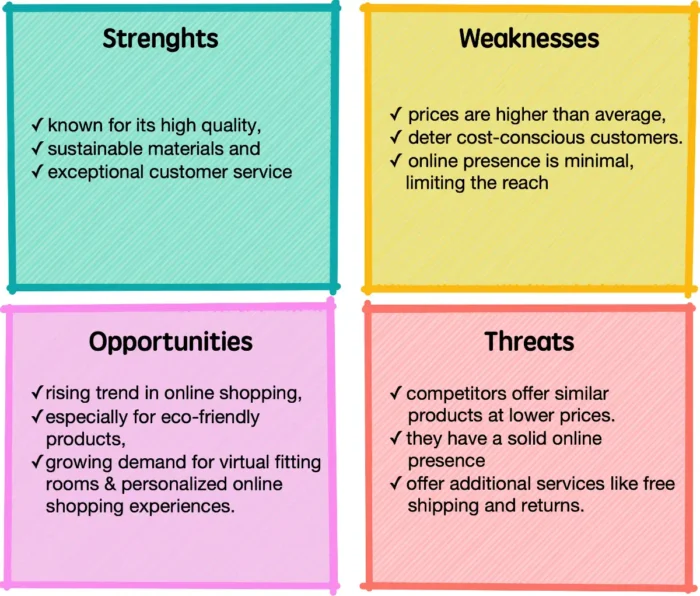
This SWOT analysis shows a clear market gap: there’s demand for an enhanced online shopping experience, especially for sustainable clothing, but existing businesses are not adequately meeting it. Your own business could fill this gap by developing a strong online presence, offering virtual fitting rooms, personalized shopping experiences, and competitive shipping and return policies.
This example demonstrates how SWOT analysis can help identify unmet needs or areas where your business can stand out, ultimately leading to the identification of market gaps.
4. Start Listening to Your Customers
Listening to your customers is one of the most effective ways to identify a gap in the market. This can be done through surveys, interviews, or user testing. By understanding their needs and pain points, you can identify growth opportunities for new products or improvements to existing ones.
Here’s a step-by-step guide on how you can use listening tools to identify a market gap:
- There are many tools available that can help you listen to your customers. These include social media listening tools (like Hootsuite or Sprout Social), review sites (like Yelp or Trustpilot), customer surveys, feedback forms, and direct customer interviews. Choose the tool(s) that best fit your business and target audience.
- Once you’ve chosen your tools, start monitoring conversations about your brand, products or services, and industry. Look for common themes, complaints, or suggestions. These could indicate a gap in the market that your own business could fill.
- After collecting data, analyze your findings. Look for patterns and trends. Are there common complaints that indicate a problem with your product or service? Are there frequent requests for a feature that you don’t currently offer? Such patterns could signify a gap in the market.
Online forums, such as Reddit and Quora, are also valuable sources of information for identifying gaps. These platforms allow users to ask questions, seek advice, and share experiences. If you participate in some online forums, you can gain valuable insights into the challenges and needs of your target audience. Look for recurring themes, common complaints, or questions that still remain unanswered. These can indicate areas where there is a lack of solutions or where existing solutions are inadequate.
Remember, the key to successful listening is collecting data and acting on the insights you gain from it. Listening to your customers can provide valuable insights into their unmet needs and help you identify market gaps your business can fill.
5. Conduct Trend Analysis
You can find excellent gaps in established markets while researching different trends. The technological and economic forces are changing over time. You need to take this into account. Trend analysis is a strategic process you can use to predict future behavior by studying past and current data.
Doing deeper research in a specific area to find a gap would be best. While researching, try to find as many things as possible that are not so obvious to other people. It doesn’t matter if you don’t have any knowledge about the untapped market or industry. Sometimes, this is better because you will escape any possible prejudgment.
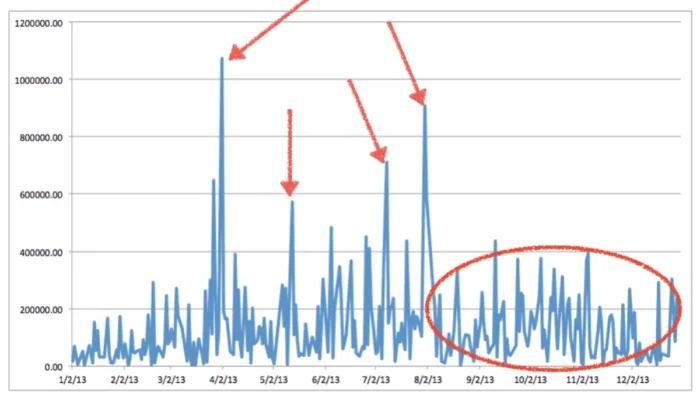
You must identify trends relevant to your industry and target market, like technological advancements, changes in consumer behavior, new laws or regulations, etc. Research the trends related to marketing, sales, suppliers, materials, manufacturing processes, etc. All these subjects probably have some gaps ready to be filled by you.
Use tools like Google Trends, social media analytics, industry reports, or other sources to collect data on these trends. Look for patterns, changes over time, and any additional insights that could indicate a potential gap in the market.
For example, using Google Trends, you might notice an increasing interest in “sustainable fashion” over the past few years. If you’re in the retail industry and find that there aren’t many sustainable options available, there’s a potential gap that your business could fill.
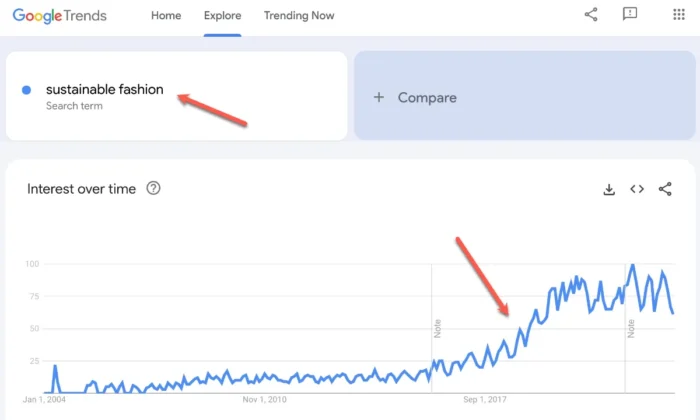
Remember that trends change over time, so you must continue monitoring them.
6. Use Web Search Tools
Using tools like Google Trends, Google Keyword Planner, or tools like SEMRush, Moz, or Ubersuggest, you can find out what people are talking about online and what questions they are asking. This can give you insights into potential gaps.
Google Keyword Planner can be an effective tool for this purpose. You’ll first need to create a Google Ads account if you don’t have one already. Once you’re logged in, navigate to the “Tools & Settings” section and select “Keyword Planner.” Choose the “Discover new keywords” option. You can enter words, phrases, or URLs related to your business to generate a list of keyword ideas.
Enter keywords related to your products or services. For example, if you’re in the organic skincare business, you might type in “organic skincare,” “natural beauty products,” “eco-friendly cosmetics,” and so on. Once you’ve entered your keywords, Google will provide data, including search volume trends and competition level. Look for keywords with high search volume but low competition.
Don’t just stop at your initial list of keywords. Explore the “related keywords” or “keyword ideas” that Google suggests. These could reveal niche areas within your market that are underserved.
Before you decide to target a potential gap, first, you must validate your findings. You could do this by testing these keywords in a small-scale ad campaign or by conducting further research to ensure there is customer demand for what you plan to offer.
For example, if you find that there are a significant number of searches for “vegan sunscreen” but not many businesses offering this product, there might be a market gap that your business can fill. As you can see in the image below, there are variations like organic instead of vegan, but also there are some searches related to travelers, and this can also be a possible business opportunity or specific untapped market niche.
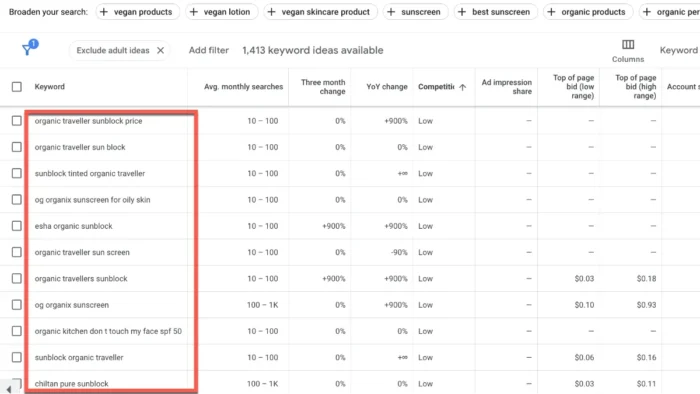
Remember, the goal is to uncover unmet needs or wants in the market that your business can serve. Google Keyword Planner provides valuable insights into what people are searching for, helping you identify potential opportunities.

Validate Potential Market Opportunities
Using previously explained steps and tools, you probably already have a business idea that can be a possible market opportunity. So, when you have identified a potential gap in the market, it’s time to validate these opportunities. These two articles can help you with this stage:
- How to Validate a Business Idea To Become 100% Sure You Will Succeed? (previously mentioned in the article)
- How to Do Technology Evaluation Before You Go With Your Startup?
Once you have validated the potential opportunity, it’s time to develop your final and viable business model. This plan should outline your market positioning, target customers, unique value proposition, marketing strategies, and financial projections. In fact, you will develop more business models and test them through the validation stage.
So, if you want to build a long-lasting successful business, follow the steps and resources from this article, and your success will be guaranteed.





